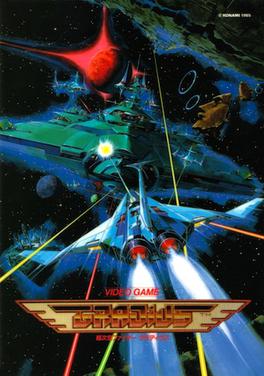
Gradius is a side-scrolling shooter video game developed and published by Konami. The first game in the Gradius series, it was originally released as a coin-operated arcade game in 1985. The player maneuvers a spacecraft known as the Vic Viper that must defend itself from the various alien enemies. The game uses a power-up system called the "power meter", based upon collecting capsules to purchase additional weapons.

Contra is a run and gun video game developed and published by Konami, originally developed as a coin-operated arcade video game in 1986 and released on February 20, 1987. A home version was released for the Nintendo Entertainment System in 1988, along with ports for various home computer formats, including the MSX2. The arcade and computer versions were localized as Gryzor in Europe, and the NES version as Probotector in PAL regions.
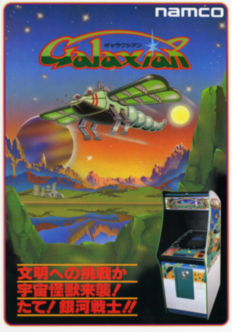
Galaxian is a 1979 fixed shooter arcade video game developed and published by Namco. The player assumes control of the Galaxip starfighter in its mission to protect Earth from waves of aliens. Gameplay involves destroying each formation of aliens, who dive down towards the player in an attempt to hit them.

Dig Dug is a maze arcade video game developed by Namco in 1981 and released in 1982, distributed in North America by Atari, Inc. The player controls Dig Dug to defeat all enemies per stage, by either inflating them to bursting or crushing them underneath rocks.

Xevious is a vertically scrolling shooter arcade video game developed and published by Namco in 1982. It was released in Japan and Europe by Namco and in North America by Atari, Inc. Controlling the Solvalou starship, the player attacks Xevious forces before they destroy all of mankind. The Solvalou has two weapons at its disposal: a zapper to destroy flying craft, and a blaster to bomb ground installations and enemies. It runs on the Namco Galaga arcade system.
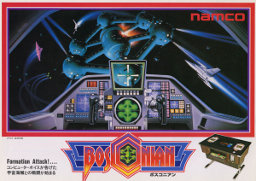
Bosconian is a scrolling multidirectional shooter arcade video game developed and released by Namco in Japan in 1981. In North America, it was manufactured and distributed by Midway Games. The goal is to earn as many points as possible by destroying enemy missiles and bases using a ship which shoots simultaneously both the front and back.

Rally-X is a maze chase arcade video game developed in Japan and Germany by Namco and released in 1980. In North America, it was distributed by Midway Manufacturing and in Europe by Karateco. Players drive a blue Formula One race car through a multidirectional scrolling maze to collect yellow flags. Boulders block some paths and must be avoided. Red enemy cars pursue the player in an attempt to collide with them. Red cars can be temporarily stunned by laying down smoke screens at the cost of fuel. Rally-X is one of the first games with bonus stages and continuously-playing background music.

Battle City is a multi-directional shooter video game for the Family Computer produced and published in 1985 by Namco. It is a successor to Namco's 1980 Tank Battalion, and would be succeeded itself by the 1991 Tank Force.

Air Combat is a 1995 combat flight simulator developed and published for the PlayStation by Namco. Players control an aircraft and are tasked with completing a series of missions, with objectives ranging from destroying formations of enemies to protecting a specific target from enemy fire. Missions award money that is used to purchase new jet fighter, each with its own unique weapons and strengths.

Galaga '88 is a 1987 fixed shooter arcade video game by Namco. It is the third sequel to Galaxian. It features significantly improved graphics over the previous games in the series, including detailed backgrounds, larger enemies and greater ship details. The game runs on Namco System 1 hardware.
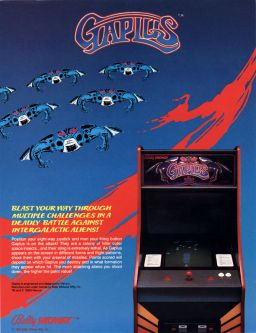
Gaplus is a 1984 fixed shooter arcade game developed and released by Namco. It is the third game in the Galaxian series, serving as a direct sequel to Galaga (1981). In North America, a modification kit was later released to change the name to Galaga 3, possibly to reflect its position in the series. It was the only game other than Phozon to run on the Namco Phozon hardware. A contemporary home port for the Commodore 64 was released in 1988. A "demastered" version of the game was included in Namco Museum Archives Vol. 2 as a bonus title.

Grobda is a 1984 multidirectional shooter arcade video game developed and published by Namco. It is a spin-off from Xevious, as the player's tank first appeared in that game as an enemy. It runs on Namco Super Pac-Man hardware but with a video system like that used in Mappy and The Tower of Druaga, and it also uses a DAC for the "Get Ready" speech sample at the start of each round.

Dragon Spirit is a 1987 vertical-scrolling shooter arcade game developed and published by Namco. In North America, it was distributed by Atari Games. Controlling the dragon Amul, the player must complete each of the game's nine areas to rescue the princess Alicia from the demon Zawell. Similar to Namco's own Xevious, Amul has a projectile weapon for destroying air-based enemies and a bomb for destroying ground enemies. It ran on the Namco System 1 arcade board.

Super Xevious is a vertically scrolling shooter released as an arcade video game in Japan in 1984. It was developed and published by Namco as an updated version of Xevious (1982) created as a response to the overwhelming success of the original in Japan. It was sold as conversion kit for existing Xevious cabinets.
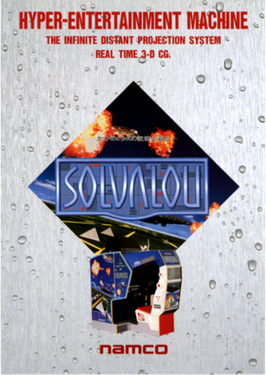
Solvalou is a 1991 first-person rail shooter arcade game developed and published in Japan by Namco. The sixth entry in the Xevious series, the player takes control of the Solvalou starship from a first-person perspective as it must destroy the Xevious forces before they take control of Earth. The Solvalou has two weapon types: an air zapper to destroy air-based enemies, and a blaster bomb to destroy ground-stationed enemies. It runs on the Namco System 21 arcade board.

Tank Force is a 1991 multi-directional shooter arcade game developed and published in Japan by Namco. It was designed by Yutaka Kounoe, whose works include Dig Dug, Lucky & Wild, and Point Blank. The game is a successor installment to Namco's Battle City (1985), itself a successor to Tank Battalion (1980). In 2017, the two-player version was re-released for the Nintendo Switch as part of the Namco Museum compilation.

Xevious: Fardraut Saga is a 1988 vertically scrolling shooter video game published by Namco for the MSX2 in Japan. An updated PC Engine version was released two years later. The fifth entry in the Xevious franchise, the player controls a spaceship in its mission to vanquish the Xevious forces before its supercomputer leader GAMP wipes out the entirety of mankind. The player uses two weapons, an air zapper to destroy air-based enemies, and a blaster bomb to destroy ground-based enemies.
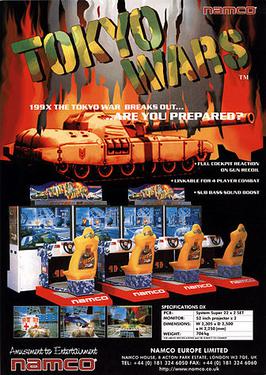
Tokyo Wars is a 1996 first-person shooter arcade game developed and published by Namco.

Tank! Tank! Tank! is a 2009 third-person shooter arcade game developed and published by Namco Bandai Games. It was ported to the Wii U in 2012, where it was a system launch title in North America. Players control their respective tanks and must destroy opponents and giant mechanical monsters with a variety of weapons, such as machine guns and rocket launchers. Its gameplay has been compared to titles such as the Earth Defense Force series, through its usage of B-movie tropes and parodying.

Galaga '91 is a 1991 fixed shooter video game developed and published by Namco for the Game Gear. It was published by Sega in Europe and renamed Galaga 2. The first portable installment in the Galaxian series, players control a lone starfighter in its mission to eradicate the hostile Galaga forces before they take over Earth. Gameplay revolves around shooting down formations of enemies and avoiding their projectiles.





















